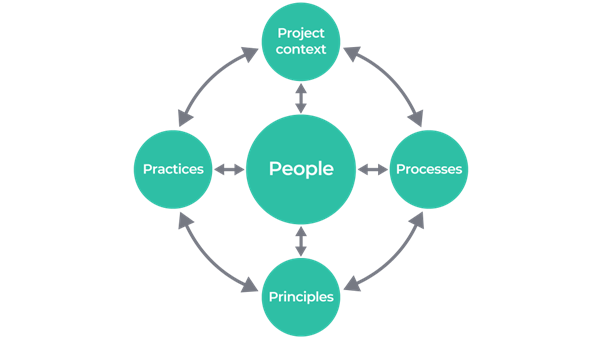I will not make the deadline
|
I will not make the deadline. This is one of the hardest realities in project management. The deadline is approaching, and your chances of meeting it are low. What do you do in this situation? Hope for the best? Take the risk and go for it? Well, the answer is complex, but I keep the following in mind. Keep sustainable pace When working in an agile way, we want to keep a sustainable pace. We try to keep this pace by working with the concept that when something is fixed, other things are flexible. Let me give you an example: We have scope, time, and budget. Scope is the size of the work needed to finish a project. Time speaks for itself. I don't want to get into time relativity theory. Let's keep it simple 😋. The budget is the money we have. This can translate into the number of people working on the project, licensing, etc.
Fixed scope and time 🫥 What now? Now, this is the optimal state. But what do you do when scope and time are fixed? If you know this beforehand, you need to put in place a projection of the project's progress. Why, you ask? Well, it is fairly simple. It can indicate earlier if you will finish the amount of work by the deadline. This helps you anticipate this situation earlier and can ensure that you still have time to onboard new team members. I just mentioned onboarding new team members. But this is with a big BUT. Putting more people on a project does not mean they will go faster. There is a point of diminishing returns where it will even slow down the team. So be careful when taking this approach. Let's take this example. Here, we have the progress from a six-week fictional project with a fixed scope and time. After the first week, we're off track. We can already raise this issue with our stakeholders by showing this chart. In week 2, the team worked hard and made better progress, but we are still not on track. In week 3, we are still not on track, and we raised the issue again with management. Now, the deadline and the scope cannot be altered, so we needed to use our last and most risky card in the deck. Add more people to the project. We freed up two experts from another team to jump in to reduce the risk of slowing down. As the experts were very familiar with the topic, they didn't need any onboarding and helped finish the project before the deadline. I hope you also noticed we used two experts from another team. So the other team lost two experts and probably slowed down in their speed. Not optimal. It happens every few months, Jelmar. Help me! If this happens every few months there is probably something wrong in the way of working. A good retrospective to find the root cause can be a good start. You can find my favorite templates in my blog. Looking for help from the outside could also be an option. Someone with a fresh perspective on the situation. If you want a free sparring session, you can book a call with me. I hope I helped you today. Take care! Jelmar PS. If you have any feedback, feel free to reply to this email. It's highly appreciated ❤️. |
Hi! I'm Jelmar a Scrum Master
I write about my Agile learning journey. Writing about the challenges I face and how I navigate this uncertain world showing that work can be different.
Hey Reader 👋, No, not really, but you can apply concepts from PRINCE2 with your team to improve collaboration with stakeholders and freedom - yes, freedom - for your team. What is PRINCE2? First things first, for those who already know PRINCE2, feel free to continue. Else, here's a quick overview. PRINCE2 defines processes to effectively manage a project and stands for PRojects IN Controlled Environments. PRINCE2 is centered around people with their 7 Practices, 7 Principles, 7 Processes, and...
Hey Reader 🤟, Are you working Agile but hating it? Are you feeling fatigued? Agile fatigue is popping up left and right. So let's dive into this topic on what it is and how we can overcome it. What is Agile fatigue? First things first, let's define what I understand of Agile fatigue. “ It's a mental and operational fatigue caused by prolonged exposure to agile processes without any tangible improvement. Symptoms Now that we are on the same line. Let's explore how to recognize the symptoms of...
Poker Planning: Have The Right Estimation Discussions What is poker planning? Poker Planning, also known as Scrum Poker, is an estimation and facilitation method for aligning a team on a user story. The practice is most commonly used in software development, where an estimation of the work has to be done. Why use poker planning estimation? I use planning poker for the following benefits. Usually, within the team, you have strong characters that could take the stage at any time. This is not a...
